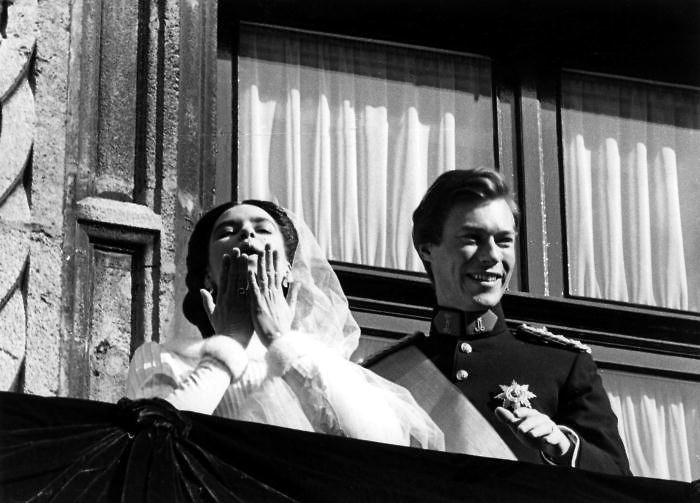by Emily Mc Mahon © Unofficial Royalty 2017
King Carl XVI Gustaf of Sweden married Silvia Sommerlath on June 19, 1976 at the Stockholm Cathedral (Storkyrkan) in Stockholm, Sweden.
Carl Gustaf’s Early Life

Carl Gustaf with his sister Christina in 1952; Credit: Wikimedia Commons
Carl Gustaf Folke Hubertus was born during the reign of his great-grandfather, Gustaf V of Sweden, at Haga Palace on April 30, 1946. Carl Gustaf was the fifth child of Gustaf Adolf, Duke of Västerbotten and Sibylla of Saxe-Coburg-Gotha. His birth following four older sisters (Margaretha, Birgitta, Desiree, and Christina) was greeted with much relief as females were at the time excluded from the succession. Carl Gustaf was third in line to the Swedish throne at birth.
Prince Gustaf Adolf was the eldest son of the future King Gustaf VI Adolf, while Sibylla was the eldest daughter of Charles Edward, the last Duke of Saxe-Coburg-Gotha. The two were great-grandchildren of Queen Victoria through her sons Arthur and Leopold. The family had made their home at Haga Palace, a 19th-century residence that had long served as a summer home for the Swedish royal family.
But the young family’s happiness was soon cut short. The Duke of Västerbotten died in a plane crash in Denmark in January 1947, when his son was only seven months old. Carl Gustaf and his sisters later said that the adults in their lives rarely spoke of the tragedy with them and that Carl Gustaf himself did not know how his father died until he was seven years old.
Sibylla and her father-in-law, Gustaf VI Adolf, supervised young Carl Gustaf’s schooling. Carl Gustaf was educated entirely in Sweden, first at the Broms School and later at the Sigtuna School where he graduated in 1966. He was a somewhat indifferent student who had a difficult time with his studies due to dyslexia, a learning disorder not well understood at the time.
Carl Gustaf served in all three branches of the Swedish military between 1966 and 1968. He was treated as an ordinary soldier during his service, where he gained praise from his superiors for his hard work and adaptability. Carl Gustaf also sailed around the world during his training, doing everything from scrubbing decks to washing dishes. The prince flourished during his time in the military but particularly during his naval training, passing the officer’s examination in 1968.
After completing his military service, Carl Gustaf studied a variety of subjects at Stockholm University and Uppsala University. He also interned with numerous welfare organizations, factories, schools, and governmental offices. Carl Gustaf spent time abroad working with the United Nations, as well as various embassies and banks, and organizations dedicated to developing nations. He also began representing his grandfather Gustaf VI Adolf in a limited number of official duties. This work was meant to give Carl Gustaf a broad range of knowledge in Swedish and international affairs in preparation for his future role as monarch. Carl Gustaf succeeded his grandfather as King of Sweden upon the latter’s death in 1973.
Carl Gustaf often said he thought of himself as an ordinary man. He drove his own car, rode by regular passenger train whenever possible, and rarely traveled with an official entourage. Had he not been born in line for the Swedish throne, he claimed he would probably have had, “an earthy job, perhaps as a farmer.”
For more information about Carl Gustaf see:
Silvia’s Early Life
Silvia Renate Sommerlath was born on December 23, 1943, in Heidelburg, Germany, to Brazilian Alice Soares de Toledo and German Walther Sommerlath. Silvia joined older brothers Ralf, Walther, and Jörg and remained the family’s only daughter. Although her father was a businessman, many of Silvia’s male relatives are and were members of the clergy.
From the ages of 4 to 14, Silvia lived in her mother’s hometown of São Paulo, Brazil. Silvia’s father worked as the head of the Brazilian branch of the Swedish Uddeholm steel company. While living in Brazil, the future Queen attended Colégio Visconde de Porto Seguro, a German-Portuguese school in Morumbi area of Sao Paulo. Silvia has had a fondness for classical music since her youth, playing the piano and organ.
Walther was long suspected of having ties to the Nazi Party before and during World War II. There is some evidence that he joined the party in 1934 while living in Brazil, but no clear record of any specific activities in which Walther may have participated. An examination of German state records revealed that Walther became the head of a company that produced equipment for tanks – a company that had recently been seized from Jewish ownership. Walther’s association with the party later became a point of concern when his daughter announced her engagement but was later dismissed due to a lack of evidence tying Walther to any known Nazi activities.
Upon the family’s return to Germany, Silvia was sent to school near Heidelberg. She completed secondary school in Düsseldorf in 1963. Silvia continued her education at the Munich School of Interpreting (Sprachen and Dolmetscher Institut München) studying the Spanish language. Silvia eventually learned to speak an impressive six languages – French, German, Spanish, Portuguese, English, and Swedish. Carl Gustaf is said to have been intrigued by Silvia’s linguistic ability from the very start of their relationship.
After her graduation from the Munich School of Interpreting in 1969, Silvia worked for a time as a Spanish interpreter at the Argentine consulate in Munich. She was hired on to the staff of the Munich Olympic Games in 1971, serving as the senior hostess and interpreter. She also trained 1,500 other hosts and interpreters in preparation for the 1972 Summer Games. Silvia followed her stint at the Munich Games with a job as the assistant chief of protocol for the 1976 Innsbruck Winter Games.
For more information about Silvia see:
The King In Love
Carl Gustaf was the first modern Swedish king to truly date. Although the Swedish monarch was not prohibited from marrying a commoner, it was expected early on that Carl Gustaf would marry a fellow royal. In fact, at the time Carl Gustaf came of age any Swedish royal other than the monarch would lose his or her royal status through marriage to a commoner. Hence, the earliest talk of a wife for Carl Gustaf centered on fellow royals.
Periodic visits to relatives in Britain in the 1960s caused gossip to flourish that Carl Gustaf was actually courting Princess Anne. During his visits, gossip flew about a possible (or ideal, by some observers) romance between Carl Gustaf and Princess Anne – that the two had made several outings together, or even that they were secretly engaged. Talk of the so-called royal romance continued into the 1970s until Anne’s marriage to Mark Phillips.
Carl Gustaf was attached at one point to Charlotte Klingspor, a wealthy Swedish heiress, and was occasionally seen in the company of Margarita of Romania. None of Carl Gustaf’s relationships with women appeared to be serious, and the King seemed very happy frequenting clubs with a tight circle of noble and royal friends. The Swedish Royal Court suggested that Carl Gustaf, being at the beginning of his reign, was concentrating on his duties rather than finding a wife.
When once interviewed about the type of woman he wanted to marry, Carl Gustaf stated that he wanted someone he loved, but her rank was unimportant. “She may be a secretary or a government official. That does not matter. The important thing is love.” The King also that he was somewhat traditional when thinking of a role for his future wife, noting that he would prefer her to take care of the home and children.
As part of her job duties, Silvia was assigned as hostess and guide to several high-profile attendees at the Games. One of Silvia’s assigned guests was Carl Gustaf. Carl Gustaf asked Silvia for a date on the day they met, and the couple had dinner just a few hours later. Carl Gustaf noted several years afterward that he and Silvia simply “clicked” upon their first meeting and had done so ever since that day.
At the time of her first meeting with Carl Gustaf, Silvia was living in a simple studio apartment in Munich and was unaccustomed to fanfare regarding her personal life. On one of her earliest trips to Stockholm to visit Carl Gustaf, Silvia allegedly disguised herself in a blonde wig to throw the tail off of curious journalists. During her subsequent visits to the Swedish capital, Silvia would stay at an apartment owned by an unnamed friend of Carl Gustaf’s.
In the spirit of keeping their relationship private, Silvia told very few of her friends that she was dating a king. When questioned by a friend about why she moved so frequently (she moved from Munich to Heidelburg to Innsbruck in 1973), Silvia hinted that she was dating someone famous, but did not mention Carl Gustaf’s name. She lamented to her friend that she moved and switched cars frequently to keep reporters away.
In early 1973, a Swedish journalist photographed Silvia and Carl Gustaf driving together. As Silvia was unknown at the time, much speculation was given as to whom Carl Gustaf was seeing. Because Carl Gustaf had previously been linked to Margarita of Romania, the press speculated that she was King’s passenger.
When they wished to escape from the eager Swedish press, Carl Gustaf and Silvia spent time skiing in Switzerland and sunning on the French and Italian Mediterranean. The two were also photographed in Munich nightclubs and on the estate of Prince Otto von Bismarck. In 1974, the couple reportedly hunted at the British royal hunting grounds on the Sandringham estate.
A newspaper report in January 1974 claimed Carl Gustaf and Silvia would marry on April 30 of that year. The report noted that Silvia and Carl Gustaf had become engaged during a visit a few weeks prior. The Swedish royal court declared that talk of an engagement was “a bit premature,” and said that the couple needed some time before deciding something so serious. Later that year, however, Silvia moved into a Stockholm apartment owned by the King’s sister Christina, giving some credence to the rumors of an engagement. However, the world would have to wait a while for the official word.
The Engagement
Together with Silvia’s parents (Carl Gustaf’s mother Sibylla had died four years earlier), Carl Gustaf and Silvia announced their engagement on March 12, 1976. Carl Gustaf and Silvia alluded to being “unofficially” engaged several months prior but had decided to wait until Silvia had completed her duties at the Olympic Winter Games in Innsbruck before making it public.
A news conference was held the next day in the King’s official apartment at the palace. Carl Gustaf said that he and Silvia had a date in mind to marry and that the ceremony would definitely take place in the early summer. When asked during the press conference what attracted Carl Gustaf to Silvia, he simply answered, “She is Silvia. You can see for yourself.”
Carl Gustaf said that he recognized his future wife already had an established career. Although he didn’t object to her working on principle, he doubted Silvia could hold a regular job as a translator while married to him. Besides, Silvia would be Queen as soon as she married Carl Gustaf, a job that was not only full-time but would incorporate Silvia’s linguistic skills. The press also asked the couple about their plans for children, to which Carl Gustaf asked to be allowed to get married first.
When asked what type of life she’d like to lead as Sweden’s queen, Silvia said she would like to live as normally as possible given her position. But the country and her new job did interest her a great deal, Silvia added. “I may have to give [up] some things after I marry, but on the other hand, I will get a sort of new job which I am very interested in,” Silvia explained. “I would like to take part in all affairs in Sweden, being a very curious person myself,” she added.
Carl Gustaf gave his fiancée a single solitaire ring set with a 2-carat diamond. The ring once belonged to his mother, Sibylla. Silvia was said to have been touched at receiving a ring with such a history. Carl Gustaf also wore a traditional and customary plain gold engagement ring.
Wedding Preparations

Silvia during a fitting for her wedding dress. Credit: hereliesthekingdom.com
The wedding was planned for June 19, 1976, the date of several other Swedish royal weddings. The future King Oscar I and Josephine of Leuchtenberg married on June 19, 1823, in Stockholm. Charles XV married his wife, Louise of the Netherlands on the same date in 1850, while he was still heir to the throne. In 2010, Crown Princess Victoria married Daniel Westling on June 19 as well.
To prepare for the couple’s tour of Stockholm following the religious service, workers created a temporary park beside the palace. This park would serve as an entryway for Silvia and Carl Gustaf to board the royal barge to tour the harbor. More than 1,000 police officers from all over Sweden were brought to Stockholm to provide crowd control and security for the couple and their guests.
The wedding would also be the first Swedish royal wedding to be broadcast on television. The event was televised in accordance with Carl Gustaf’s wish that the wedding celebrations be as open and accessible to as many people as possible. While royal weddings had been televised in other countries for several years, this had yet to be done in Sweden as none of Carl Gustaf’s sisters had had a televised ceremony. The Swedish wedding was also unique in that as soon as the couple was declared married, the country would automatically have a new Queen.
The wedding costs were estimated at $1.1 million, but the wedding itself was expected to be a moneymaker in terms of broadcasting rights and potential tourism dollars spent in and around the city of Stockholm.
Celebrations in Stockholm

ABBA performed the first live and the first Swedish performance of “Dancing Queen” at the Royal Swedish Opera Gala in honor of King Carl Gustaf and his soon-to-be Queen
The wedding celebrations got off to a rough start when, about two weeks before the wedding, Silvia came down with the flu. She was unable to make a planned appearance with the King on June 6 (Sweden’s National Day) due to her condition. Silvia was still feeling under the weather the following day when the banns were read in the palace’s chapel. Although reportedly appearing “pale and tired,” Silvia attended the event with a smile.
When asked if she was nervous about her coming wedding, Silvia said she was not. “[I have] no butterflies in my stomach because of the tremendous reception I have received in Sweden.” On June 17, Silvia received the Order of the Seraphim and officially became a Swedish citizen the following day. On June 18, the King and the soon-to-be-Queen attended a gala performance at the Royal Swedish Opera. The gala was especially notable for the performance of Swedish band ABBA, at the peak of their fame, of the first live and the first Swedish performance of “Dancing Queen,” one of ABBA’s most famous songs. Despite the title, members of ABBA noted that the song had not been written specifically for the event or for Silvia.
The pre-wedding concert at the Royal Opera marked the first time Silvia publicly wore a tiara (the Connaught Diamond Tiara), a favorite of Carl Gustaf’s mother Sibylla. The event was also the first occasion of Silvia’s wearing of her new Order of the Seraphim. A reception and dance for 200 guests at Drottningholm Palace followed the performance at the Royal Opera.
Wedding Ceremony

Carl Gustaf and Silvia during the recessional at their wedding. Photo credit: svspb.net
The ceremony was held on June 19, 1976, at Stockholm’s Storkyrkan (Great Church) with the Archbishop of Uppsala Olof Sundby presiding. Sundby was assisted by Hans Akerhelm, the first chaplain to the court, and the Reverend Ernst Sommerlath, Silvia’s uncle and a former professor of theology at Leipzig University.
The church was decorated with a new breed of red roses named “Queen Silvia”, in honor of the bride and her new role. The roses were held in two silver vases chosen by Silvia that had belonged to Louise, a previous Swedish queen. Two historic crowns were also brought from the Swedish national treasury to be displayed during the wedding. The two crowns displayed were those of King Erik XIV and 18th-century monarch Queen Louisa Ulrika. The crowns rested on blue cushions on either side of the altar. Other decorations included a seventeenth-century crucifix in oak, gold, and silver that had been made for Queen Christina’s coronation. Guests listened to the Swedish Radio symphony orchestra’s performance of various traditional Swedish music.
Mr. and Mrs. Sommerlath took their seats just before noon, not long before the processional began. The couple entered the cathedral to the strain of J. H. Roman’s “Sinfonia de Chiesa.” Carl Gustaf “beamed” as he made his way to the altar holding Silvia’s hand. Silvia and Carl Gustaf had six children serve as their attendants:
- Prince Hubertus of Hohenzollern (son of Carl Gustaf’s sister Princess Birgitta)
- Baroness Hélène Silfverschiöld (daughter of Carl Gustaf’s sister of Princess Desiree)
- Carmita Sommerlath (daughter of Silvia’s brother Ralf Sommerlath; carried the wedding ring)
- James Ambler (son of Carl Gustaf’s sister of Princess Margaretha)
- Sophie Sommerlath (daughter of Silvia’s brother Walther Sommerlath)
- Amelie Middelschulte (daughter of Silvia’s close friend Beate Middelschulte)
The religious ceremony lasted approximately 40 minutes and included several Swedish hymns. Silvia and Carl Gustaf elected to have a single ring ceremony according to German tradition; thus Carl Gustaf placed a ring on his wife’s finger, but Silvia did not do the same for her husband. Silvia delivered her vows in nearly perfect Swedish, impressing the guests and the Swedish public watching on television. Neither the bride nor groom was asked to obey the other, a somewhat new practice in the church and a sign of changing times.
At the conclusion of the religious service, Silvia and Carl Gustaf made their way down the aisle to J. S. Bach’s “Sinfonia in D Major.” Television broadcasters noted when announcing that at precisely 12:21 PM, Sweden had its first queen in 11 years, since the death of Carl Gustaf’s step-grandmother Louise.
Wedding Attire

Carl Gustaf, Silvia, and their wedding party. Photo credit: royalty online.blogspot.com
Silvia chose Marc Bohan of Dior to design her wedding dress, a floor-length white duchesse silk gown. The dress was very simple in its design as it featured no lace, trim, embroidery, or decorative buttons. The structure of the dress included a very gentle A-line skirt, long bell sleeves, a jewel neckline, and a 12-foot train that fell from Silvia’s shoulders. Carl Gustaf’s sisters Birgitta and Desiree also wore the train as part of their own wedding ensembles.
The dress’s starkness was meant to showcase the other elements in Silvia’s ensemble, particularly the tiara and veil. Silvia wore one of the oldest, most well-known, and arguably most unique tiaras in the Swedish royal collection. The Cameo Tiara was a gift given by French Emperor Napoleon I to his then-wife, Josephine, in the early 19th century. It came into the hands of the Swedish royal family through the marriage of Josephine’s granddaughter (another Josephine) to Oscar I of Sweden. The diadem features cameos of various portraits and scenes from Greek mythology adorned with yellow gold and numerous pearls of various sizes. Although cameo tiaras were once quite commonly worn, the Swedish Cameo Tiara is thought to be one of the only cameo tiaras of its kind still in use. Carl Gustaf’s sisters Birgitta and Desiree had previously worn the Cameo Tiara on their wedding days; Silvia and Carl Gustaf’s daughter Victoria continued the tradition when she wore it for her own wedding in 2010.
Silvia’s lace veil was originally owned by Sofia of Nassau, the consort of Oscar II. Carl Gustaf’s mother Sibylla wore it at her 1932 wedding. Sibylla’s daughters Desiree, Margaretha, and Christina subsequently wore the veil as well. Although the veil was originally intended to cover the length of Silvia’s train, a miscalculation was made in the construction of the train. As a result, Silvia folded part of the lace veil over the tiara in order to compensate for the shorter train and to prevent the lace from being damaged. As with the Cameo Tiara, Victoria also wore the heirloom veil on her wedding day.
Sprigs of myrtle from a plant belonging to Carl Gustaf’s grandmother Margaret trimmed the veil and tiara; the wearing of myrtle in the wedding is thought to bring a Swedish bride good luck. Silvia wore very little jewelry, forgoing a necklace and bracelets, and wearing only a pair of tiny pearl earrings. She carried a bouquet of orchids and jasmine complemented by lilies of the valley and stephanotis, completing the ensemble.
On a somewhat more comical note, Silvia’s simple dress had no pockets or anywhere to discreetly place a handkerchief. Alice Sommerlath insisted her daughter carry one in case she became tearful during the ceremony (she never did). Silvia had little choice but to hastily fasten the handkerchief to her right wrist with a rubber band. Although the handkerchief was not visible during the ceremony due to the long sleeves of the dress, it was very visible whenever Silvia waved.
Carl Gustaf wore his Swedish naval admiral’s uniform. He wore the insignia of all four Swedish orders – the Order of the Seraphim, Order of the Sword, Order of the Polar Star, and Order of Vasa. According to some sources, Carl Gustaf also wore the Order of Merit of the German Federal Republic in honor of his bride’s origins.
The Tour Through Stockholm
Embed from Getty Images
Carl Gustaf and Silvia on their carriage ride through Stockholm
The royal couple was carried in an open horse-drawn landau through the streets of Stockholm waving to the crowds of between 150,000 and 180,000 lining the streets, many of who had been there since the early morning hours. Carl Gustaf and Silvia were greeted by cheers from the spectators, most of who were waving miniature Swedish flags or holding balloons printed with the couple’s pictures.
On Skeppsholmen Island opposite the palace, the King and his new Queen then boarded the royal barge, Vasaorden, to review Swedish naval ships parked in the harbor. As Carl Gustaf and Silvia toured by barge, three divisions of Swedish Air Force jets drew a large white heart in the sky during a 21-gun salute by the Swedish Navy.
The couple then disembarked the Vasaorden and walked into the palace serenaded by over 200 folk musicians from Dalarna playing a Swedish bridal march. The two were greeted by the Governor of the Royal Palace Sixten Wohlfahrt, who formally welcomed the King and new Queen to the palace for the first time. Carl Gustaf and Silvia then appeared on the balcony of the Royal Palace to greet the crowds. Carl Gustaf lifted Silvia’s hand and declared their happiness to a cheering crowd.
Reception
After the harbor tour, the royal couple remained at the Royal Palace for a luncheon with 300 guests in the Vita Havet (White Sea) stateroom. Strolling fiddlers and pipers during the meal serenaded the diners. Carl Gustaf’s uncle Bertil served as the formal host and gave a speech welcoming Silvia into the family and into her new role as Queen.
Royal head chef and renowned restaurateur Werner Vögeli prepared the wedding buffet. The menu included salmon mousse baked in puff pastry, jellied consommé with caviar, Scottish forest pigeon, foie gras, and wild strawberries and ice cream. Croquembouche decorated with pink marzipan flowers served as a wedding cake.
Silvia had previously complimented the salmon mousse when she sampled it prior to the wedding. Wanting to do something special for the new Queen, Vögeli copied the recipe for the mousse on a special card, which was placed at Silvia’s seat before the banquet as a keepsake. Vögeli, originally a Swiss citizen, went on to cater many of the official dinners and banquets during the early years of Carl Gustaf’s reign.
Wedding Guests
Silvia and Carl Gustaf with their families and royal and political guests. Photo credit: thepinkroyals.blogspot.com
Although Carl Gustaf’s and Silvia’s wedding was attended by fewer royals than some ceremonies before and since, the ceremony still drew about 1200 guests.
Among the most notable guests at the wedding were:
- Prince Bertil of Sweden, Duke of Halland
- Lillian Craig (Lillian became Duchess of Halland later that year)
- Walther and Alice Sommerlath
- Ralf and Charlotte Sommerlath
- Jörg Sommerlath
- Walther (Silvia’s brother) and Michele Sommerlath
- Princess Margaretha of Sweden and John Ambler
- Princess Birgitta (of Sweden) and Prince Johann Georg of Hohenzollern
- Princess Désirée of Sweden and Baron Nils-August Otto Carl Niclas Silfverschiöld
- Princess Christina of Sweden and Tord Magnuson
- Louis Mountbatten, 1st Earl Mountbatten of Burma
- Richard and Birgitte, Duke and Duchess of Gloucester (official representatives of the British monarchy)
- Princess Beatrix and Prince Claus of the Netherlands
- Grand Duke Jean and Grand Duchess Josephine-Charlotte of Luxembourg
- Queen Ingrid of Denmark
- King Constantine II and Queen Anne-Marie of Greece (former)
- King Olav V of Norway
- Queen Margrethe II and Prince Henrik of Denmark
- Princess Benedikte of Sayn-Wittgenstein-Berleburg (formerly of Denmark)
- King Baudouin and Queen Fabiola of the Belgians
- Urho Kaleva Kekkonen, President of Finland
- Dr. Kristján Eldjárn, President of Iceland, and Halldora Eldjárn
- Walter Scheel, President of the Federal Republic of Germany (West Germany), and Mildred Scheel
Honeymoon and Afterward
Six hours after the wedding, the bride and groom left Stockholm to begin their month-long honeymoon. Before leaving, Carl Gustaf expressed his belief that the press would likely not follow them. “There’s a good chance,” he said happily, “that we will be left alone.”
The couple first headed to the US state of Hawaii, where they hoped to begin their honeymoon “just like any married couple.” The two were met with a security entourage so vast that Rick Larsen, the Swedish Consul in Hawaii, had a tough time finding the couple to welcome them. Larsen managed to reach Silvia first, who received a traditional lei around her neck. While in Hawaii, Carl Gustaf and Silvia stayed at a private estate owned by Lurline Roth, a shipping heiress.
Carl Gustaf and Silvia then headed to Botswana, where the two stayed in a tent near the Linyanti River. The area in which the two stayed was later renamed Kingspool in honor of its royal guests. The couple followed their Hawaiian and African honeymoon with a short stay at the Solliden Palace in Öland, where they were first pictured together three years prior.
The wedding did a great deal to bolster the popularity of Carl Gustaf and the Swedish monarchy itself. Both had met with considerable criticism from the start of Carl Gustaf’s reign for the usual reasons. Detractors questioned the necessity of the institution and believed Carl Gustaf was too irresponsible for the position. The marriage of Carl Gustaf to Silvia brought stability to the monarchy, and their romance warmed the hearts of even the most virulent critics.
Children
Embed from Getty Images
Carl Gustaf and Silvia with their three children in 1983
Carl Gustaf and Silvia had two daughters and one son:
- Crown Princess Victoria, Duchess of Västergötland (born 1977), married Daniel Westling, had one daughter and one son, the Swedish Royal Family descends from this marriage
- Prince Carl Philip, Duke of Värmland (born 1979), married Sofia Hellqvist, had two sons
- Princess Madeleine, Duchess of Hälsingland and Gästrikland (born 1982), married Christopher O’Neill, had two daughters and one son
This article is the intellectual property of Unofficial Royalty and is NOT TO BE COPIED, EDITED, OR POSTED IN ANY FORM ON ANOTHER WEBSITE under any circumstances. It is permissible to use a link that directs to Unofficial Royalty.







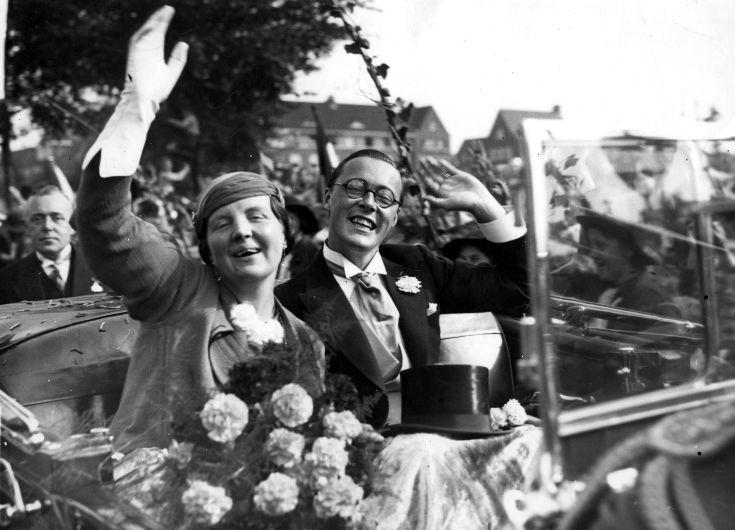

























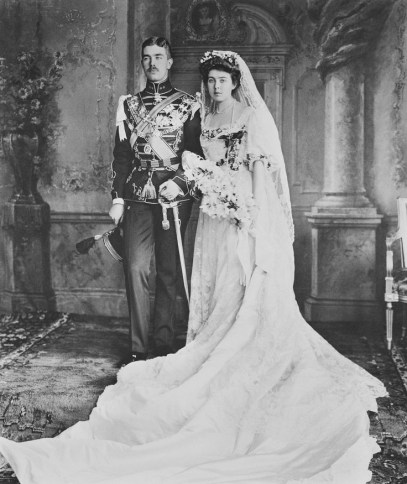

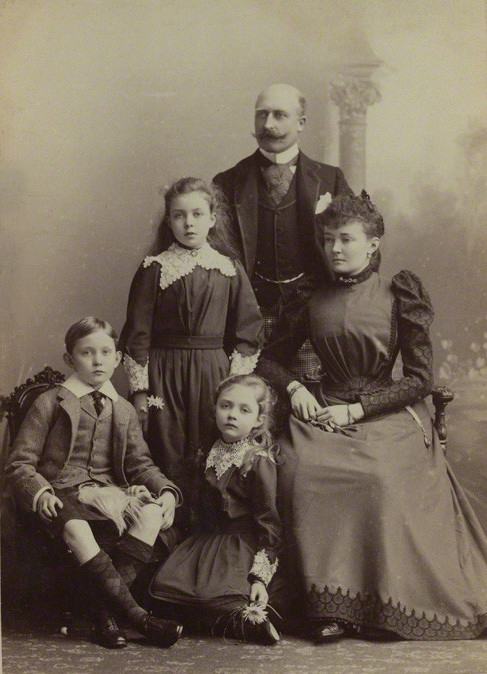









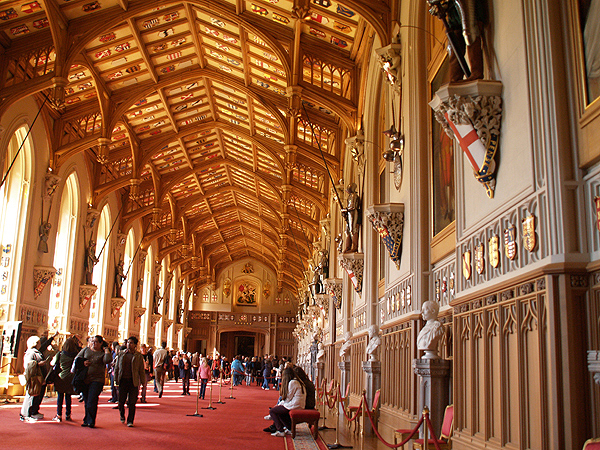













.jpg?resize=538%2C403)
